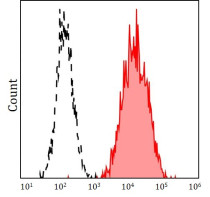ARG44606
anti-Galectin 3 antibody [M3/38] (APC)
anti-Galectin 3 antibody [M3/38] (APC) for Flow cytometry and Human,Mouse
Overview
| Product Description | APC-conjugated Rat Monoclonal antibody recognizes Galectin 3 |
|---|---|
| Tested Reactivity | Hu, Ms |
| Tested Application | FACS |
| Host | Rat |
| Clonality | Monoclonal |
| Clone | M3/38 |
| Isotype | IgG2a kappa |
| Target Name | Galectin 3 |
| Antigen Species | Human |
| Conjugation | APC |
| Alternate Names | LGALS3; Galectin 3; GALIG; Advanced Glycation End-Product Receptor 3; Lectin, Galactoside-Binding, Soluble, 3; Carbohydrate-Binding Protein 35; Galactose-Specific Lectin 3; Laminin-Binding Protein; IgE-Binding Protein; 35 KDa Lectin; Lectin L-29; Galectin-3 ; LGALS2; MAC-2; GALBP; MAC2; Epididymis Secretory Sperm Binding Protein; Galactoside-Binding Protein; MAC-2 Antigen; Mac-2 Antigen; CBP 35; CBP35; Gal-3; GAL3; L-31; L31 |
Application Instructions
| Application Suggestion |
|
||||
|---|---|---|---|---|---|
| Application Note | * The dilutions indicate recommended starting dilutions and the optimal dilutions or concentrations should be determined by the scientist. |
Properties
| Form | Liquid |
|---|---|
| Purification | Purified antibody is conjugated with activated allophycocyanin (APC), and unconjugated antibody and free fluorochrome are removed by size-exclusion chromatography. |
| Buffer | PBS (pH 7.4) and 15 mM Sodium azide |
| Preservative | 15 mM Sodium azide |
| Storage Instruction | Aliquot and store in the dark at 2-8°C. Keep protected from prolonged exposure to light. Avoid repeated freeze/thaw cycles. Suggest spin the vial prior to opening. The antibody solution should be gently mixed before use. |
| Note | For laboratory research only, not for drug, diagnostic or other use. |
Bioinformation
| Database Links | |
|---|---|
| Gene Symbol | LGALS3 |
| Gene Full Name | lectin, galactoside-binding, soluble, 3 |
| Background | This gene encodes a member of the galectin family of carbohydrate binding proteins. Members of this protein family have an affinity for beta-galactosides. The encoded protein is characterized by an N-terminal proline-rich tandem repeat domain and a single C-terminal carbohydrate recognition domain. This protein can self-associate through the N-terminal domain allowing it to bind to multivalent saccharide ligands. This protein localizes to the extracellular matrix, the cytoplasm and the nucleus. This protein plays a role in numerous cellular functions including apoptosis, innate immunity, cell adhesion and T-cell regulation. The protein exhibits antimicrobial activity against bacteria and fungi. Alternate splicing results in multiple transcript variants.[provided by RefSeq, Oct 2014] |
| Function | In the nucleus: acts as a pre-mRNA splicing factor. Involved in acute inflammatory responses including neutrophil activation and adhesion, chemoattraction of monocytes macrophages, opsonization of apoptotic neutrophils, and activation of mast cells. Together with TRIM16, coordinates the recognition of membrane damage with mobilization of the core autophagy regulators ATG16L1 and BECN1 in response to damaged endomembranes. [UniProt] |
| Cellular Localization | Cytoplasm, Nucleus, Secreted, Spliceosome. [UniProt] |
| Calculated MW | 26 kDa |
| PTM | Acetylation, Disulfide bond, Phosphoprotein |
Images (1) Click the Picture to Zoom In






